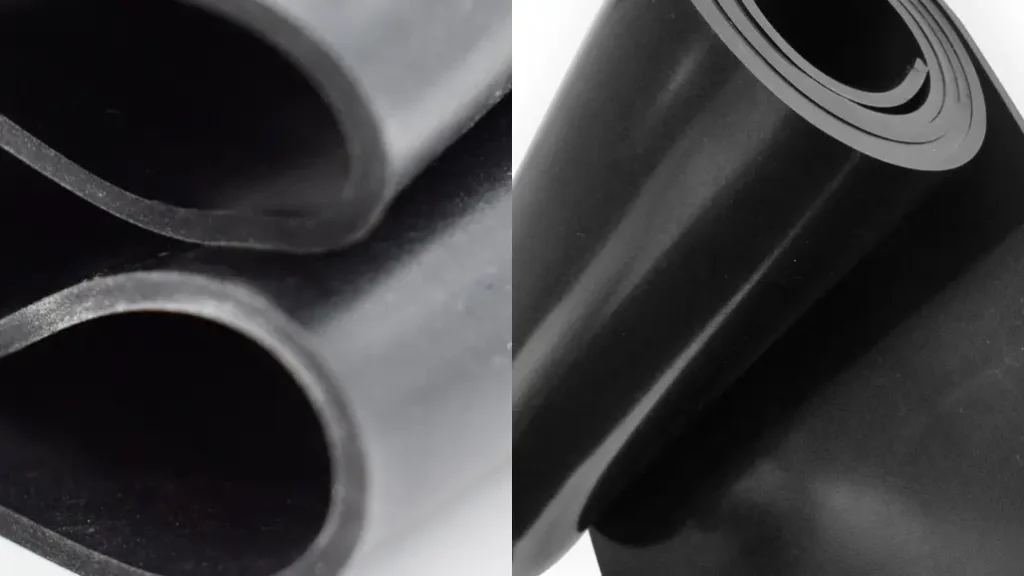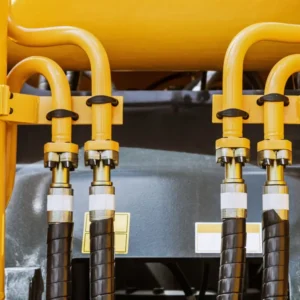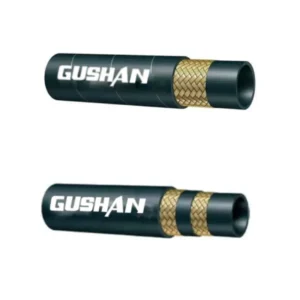When selecting hydraulic hoses, material choice is critical. EPDM and Nitrile are popular options, each offering unique properties. This blog explores their temperature and chemical resistance, crucial factors for optimal hydraulic system performance. We’ll delve into their strengths, helping you make informed decisions.
Understanding the differences between EPDM and Nitrile ensures your hydraulic hoses withstand demanding conditions. We’ll examine their capabilities in various environments, focusing on fluid compatibility and temperature tolerances. This guide empowers you to choose the right material for reliable and long-lasting hydraulic operations.
What Is EPDM
EPDM, or Ethylene Propylene Diene Monomer, is a type of synthetic rubber known for its exceptional resistance to weathering, ozone, UV radiation, and a wide range of chemicals. It’s a highly versatile elastomer that maintains its flexibility and durability across a broad temperature range, making it ideal for outdoor applications and environments exposed to harsh conditions.
EPDM’s unique properties stem from its saturated polymer backbone, which provides superior resistance to degradation compared to unsaturated rubbers.
EPDM for Hydraulic Hoses

EPDM is a valuable material for hydraulic hoses, particularly in applications where environmental resistance is crucial. Its inherent properties make it suitable for specific hydraulic systems, though it’s important to understand its limitations. EPDM’s resistance to weathering, ozone, and UV radiation ensures longevity in outdoor settings, where traditional rubber hoses might degrade quickly.
Benefits:
- Excellent resistance to weathering, ozone, and UV radiation.
- Good temperature resistance, maintaining flexibility in a wide range.
- Resistance to many chemicals, including water and some acids.
- Suitable for outdoor hydraulic systems and applications with exposure to harsh environments.
However, EPDM is not ideal for all hydraulic applications. Its resistance to petroleum-based fluids, such as mineral oils and hydraulic fluids, is relatively poor compared to nitrile rubber.
Therefore, it’s primarily used in hydraulic systems using phosphate ester-based fluids or water-based hydraulic fluids. While it provides good temperature resistance, it might not be the best choice for extremely high-pressure or high-temperature hydraulic systems that require specialized materials.
What Is Nitrile
Nitrile rubber, also known as NBR (Nitrile Butadiene Rubber), is a synthetic rubber copolymer of acrylonitrile and butadiene. It’s widely recognized for its excellent resistance to oils, fuels, and other petroleum-based fluids, making it a preferred material in applications involving contact with hydrocarbons.
Nitrile also exhibits good abrasion resistance and tensile strength, contributing to its durability in demanding environments. However, it’s less resistant to weathering and ozone compared to EPDM.
Nitrile for Hydraulic Hoses

Nitrile rubber is a highly favored material for hydraulic hoses, particularly in applications where resistance to petroleum-based hydraulic fluids is paramount. Its inherent properties make it well-suited for a wide range of hydraulic systems, ensuring reliable performance and longevity. Nitrile’s excellent oil and fuel resistance makes it the go-to choice for hoses that transport mineral oils, hydraulic fluids, and other hydrocarbons.
Benefits:
- Superior resistance to oils, fuels, and petroleum-based hydraulic fluids.
- Good abrasion resistance and tensile strength, enhancing durability.
- Suitable for high-pressure hydraulic systems using mineral oils.
- Provides reliable performance in demanding industrial environments.
However, nitrile is not without its limitations. Its resistance to weathering, ozone, and UV radiation is less than that of EPDM, making it less ideal for outdoor applications where prolonged exposure to these elements is expected. Also, while very good with petroleum based fluids, it is not ideal for phosphate ester or water-based fluids.
Therefore, for hydraulic systems that operate in harsh outdoor conditions or utilize phosphate ester-based fluids, alternative materials might be more suitable. Proper material selection is essential to ensure the longevity and reliable performance of hydraulic hoses.
EPDM vs Nitrile

When selecting materials for hydraulic hoses, EPDM and nitrile rubber present distinct advantages and limitations. EPDM excels in applications demanding resistance to weathering, ozone, and UV radiation, making it ideal for outdoor hydraulic systems. Its ability to withstand a broad temperature range and resistance to water-based fluids further enhance its suitability. However, EPDM’s poor resistance to petroleum-based fluids limits its use in systems employing mineral oils.
EPDM Hydraulic Hose Advantages:
- Excellent weathering and ozone resistance.
- Good temperature flexibility.
- Suitable for water-based and phosphate ester hydraulic fluids.
- Ideal for outdoor applications.
Nitrile, conversely, shines in environments where resistance to oils, fuels, and petroleum-based hydraulic fluids is crucial. Its superior abrasion resistance and tensile strength contribute to its durability in demanding industrial settings. However, nitrile’s lower resistance to weathering and ozone makes it less suitable for prolonged outdoor exposure.
Nitrile Hydraulic Hose Advantages:
- Superior resistance to mineral oils and petroleum-based fluids.
- Good abrasion resistance and tensile strength.
- Suitable for high-pressure hydraulic systems using mineral oils.
- Ideal for indoor industrial applications.
Ultimately, the choice between EPDM and nitrile hinges on the specific operating conditions and fluid compatibility requirements of the hydraulic system. For outdoor applications or systems utilizing water-based fluids, EPDM is the preferred choice. For systems using mineral oils or petroleum-based fluids, nitrile offers superior performance.
| Feature | EPDM | Nitrile |
| Oil Resistance | Poor | Excellent |
| Weather Resistance | Excellent | Poor |
| Temperature Range | Wide | Moderate |
| Fluid Compatibility | Water-based, Phosphate Ester | Petroleum-based |
| Abrasion Resistance | Moderate | Good |
| Tensile Strength | Moderate | Good |
| Ideal Application | Outdoor, Water-based systems | Indoor, Oil-based systems |
How to Choose EPDM and Nitrile Hydraulic Hoses
Selecting the right EPDM or nitrile hydraulic hose requires careful consideration of the application’s specific needs. Begin by assessing the operating environment and the types of fluids that will be transported. If the hose will be exposed to outdoor conditions, ozone, or UV radiation, EPDM is the preferred choice.
For systems using petroleum-based hydraulic fluids, nitrile offers superior resistance. Next, determine the operating temperature range and pressure requirements of the system. Ensuring the hose’s specifications align with these parameters is crucial for optimal performance and safety.
Key Considerations:
- Fluid Compatibility: Match the hose material to the type of hydraulic fluid used.
- Operating Temperature: Select a hose that can withstand the system’s temperature range.
- Pressure Requirements: Ensure the hose’s pressure rating exceeds the system’s maximum pressure.
- Environmental Conditions: Consider exposure to weather, ozone, and chemicals.
- Application Specifics: Factor in any unique requirements, such as abrasion resistance or flexibility.
Ultimately, the choice between EPDM and nitrile depends on the balance of these factors. Consult manufacturer specifications and consider seeking expert advice to ensure you select the most suitable hydraulic hose for your application.
Proper selection minimizes the risk of premature hose failure and ensures the safe and efficient operation of your hydraulic system.
Conclusion
In hydraulic hose applications, material selection is paramount. EPDM excels in weathering and high-temperature environments, while nitrile offers superior oil and fuel resistance. Understanding these differences ensures optimal hose performance and longevity. Choose EPDM for outdoor, high-heat scenarios, and nitrile for systems with petroleum-based fluids.
Ultimately, the best choice depends on the specific demands of your hydraulic system. Consider operational temperatures, fluid compatibility, and environmental factors. Proper material selection minimizes failures and maximizes efficiency. Both materials offer distinct advantages, making them valuable in diverse hydraulic applications.
For tailored hydraulic hose solutions, including EPDM and nitrile options, contact Gushan Rubber. We provide high-quality hoses designed for demanding applications. Request a quote today and experience the difference in performance and reliability.



